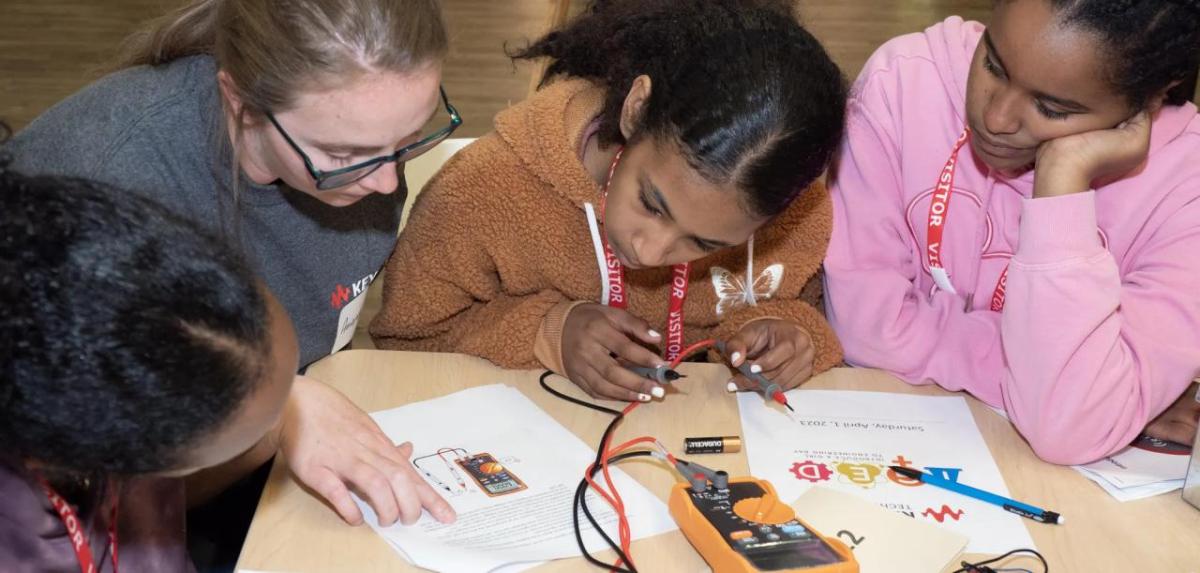The Benefits of Early STEM Education
By Marie Hattar CHIEF MARKETING OFFICER

Children have natural tendencies to explore, create, and innovate. By encouraging STEM education early on in their lives — before high school, and even before middle school — we can nurture the next generation of engineers, scientists, and technology leaders. In this article, we’ll share the benefits of early STEM education as well as Keysight’s efforts to encourage future STEM leaders.
What are the benefits of early STEM education?
Encouraging STEM learning from an early age unleashes children’s innate curiosity and gives them the confidence to evolve into life-long problem-solvers in their future academic and professional pursuits. Exposure to the STEM fields at a young age helps to:
- Foster innate curiosity: STEM education helps children learn to ask questions, explore possibilities, and develop a natural interest in the world around them.
- Improve collaboration: Many STEM activities involve group projects that require teamwork and collaboration — important skills in both professional and social settings.
- Develop problem-solving skills: STEM programs give children the tools they need to be analytical, think critically, and come up with creative solutions to solve problems.
- Spark interest and motivation: Early exposure makes STEM concepts feel more familiar to kids later on, which can help motivate them to continue pursuing these interests.
- Prepare for future endeavors: Early childhood STEM education lays the foundation for more advanced learning in these fields, which better prepares children for future academic challenges.
How Keysight Encourages Future STEM Leaders
Keysight employees know me as their Chief Marketing Officer, but I started my career in STEM as an electrical engineer. My dad was a doctor, and he helped spark my interest in the science behind his work. But after a few biology classes, I discovered I didn’t like “the dissection stuff,” as I called it at the time. So, I explored other science-related fields, and since math was always a strong subject for me, I landed on engineering.
As an engineer and now as a CMO, it’s exciting for me to be a leader of an organization like Keysight, which has several initiatives to improve STEM education and help spark interest at a young age.
At the university level, I’m proud to be a part of the Keysight Innovation Challenge, a worldwide, women-led student competition to design innovations with real-world applications to address climate change. Keysight also has a partnership with the Mathematics Engineering Science Achievement (MESA) association to pair Keysight mentors with students for the organization’s statewide leadership conference competition — and works with many universities around the world to provide scholarships, internship opportunities, corporate advisory engagements with company executives, and engineering lab equipment grants.
But effectively nurturing STEM careers means engaging students from the start — during their high school years and even before. A Girl Scouts report found that middle school is a critical juncture where STEM aspirations are abandoned by many students, but especially women and underrepresented groups. Programs that pay special attention to these pivotal moments will help provide the necessary exposure, support, and motivation for students to remain committed to careers in STEM.
To strengthen middle schoolers’ STEM interests, Keysight is a corporate sponsor of the Mike Hauser Academy for STEM, a summer school program for incoming ninth-graders in Santa Rosa, CA. We also participate in Expanding Your Horizons to introduce middle school girls to careers in STEM and provide hands-on activities for students at the North Bay Science Discovery Day. Across the globe, our Penang, Malaysia site hosted an Introduce a Girl to Engineering Day and partners with other technology companies in the area in the Girls in Engineering & Technology (GET) program.
And our beloved Keysight After School Program, facilitated by employee volunteers, delivers hands-on electronics, physics, and earth-science experiments to schools, with all the materials needed for students to explore various STEM concepts.
These are just a few of Keysight’s many STEM education initiatives, which aim to not only promote educational opportunities, but inspire and empower students as they pursue their ideal careers.
Investing in Early STEM Education to Solve Tomorrow’s Challenges
Even though I’m no longer a practicing engineer, I’m grateful for my STEM education — and still apply the critical thinking and collaboration skills I learned as an engineer every day.
By focusing on early exposure to STEM, we can help children develop an interest that paves the way for future career opportunities and innovations to solve the world’s biggest challenges.

